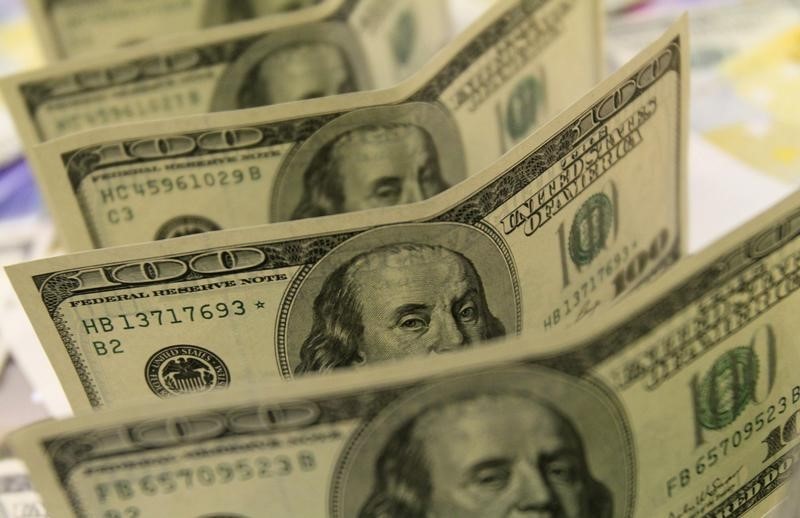By Gertrude Chavez-Dreyfuss and Ashley Lau
NEW YORK (Reuters) - U.S. investors spooked by wild swings in the foreign exchange market are piling into exchange-traded funds that strip out the local currency on their international equity portfolios, making them one of the most sought-after financial products in 2015.
With the dollar having rallied more than 19 percent since the beginning of 2014, investors are seeing gains in overseas stock markets eaten up by losses against the greenback.
"People are voting with their feet," said Luciano Siracusano, chief investment strategist for WisdomTree Investments in New York. "They're putting billions of dollars into these funds, and what they're saying is, 'We don't want to be 100 percent unhedged.'"
Some say there aren't enough of these products for investors looking for international exposure. These ETFs have about $31.5 billion in assets, up nearly five-fold from 2011. But assets in international equity ETFs exceed $275 billion, according to WisdomTree.
"There are 40 countries with stock markets deep enough to have a currency-hedged product," said David Kotok, chairman and chief investment officer of Cumberland Advisors in Sarasota, Florida, which oversees $2 billion, and whose firm's equity investments are solely through ETFs.
"If you look at the ETF offerings, you have hundreds available to craft a U.S.-centric portfolio. But how many do you have in the euro zone? You have maybe a dozen ETFs for China. You have the world's second largest economy and you only have a dozen?"
WisdomTree, with ETF assets of about $44 billion, is the leader in the currency-hedged space with 80 percent of the market. The other two major players are Deutsche Bank, with $5.2 billion in currency-hedged assets, and BlackRock Inc., overseeing about $1 billion in hedged ETFs.
All three are planning to expand their currency-hedged offerings, officials at the firms said.
Guggenheim Investments, which has its own suite of currency ETFs with $1.1 billion in assets, also plans to launch currency-hedged ETFs, officials there told Reuters. The company has $28.8 billion in ETF assets.
CURRENCY SWINGS
Rising forex-market volatility has spurred demand for currency-hedged ETFs.
The Federal Reserve has ended its money-printing program, while the European Central Bank and Bank of Japan are both in the midst of easing plans. The dollar, as a result, last year hit its highest level against the euro since 2003 and hit a seven-year high against the yen. A strong dollar reduces returns on these portfolios when converted into the U.S. currency.
It's a trend that Dodd Kittsley, head of ETF strategy and national accounts at Deutsche Bank Asset and Wealth Management in New York, expects to continue for several years.
In the strong dollar environment, hedged ETFs have so far been outperforming their unhedged counterparts.
WisdomTree Europe Hedged Equity Fund is up 8.4 percent year-to-date, while its unhedged peers, the iShares Europe ETF and the Vanguard FTSE Europe ETF, were up just 0.5 percent this year, Morningstar data show.
The HEDJ ETF has so far garnered $3.1 billion in inflows in 2015, about half of the $5.9 billion into currency-hedged ETFs in January, according to ETF.com. Last year, the fund posted a return of 6.6 percent, while the unhedged iShares ETF and Vanguard ETF lost 6 percent and 6.6 percent, respectively.
IS IT WORTH IT?
But hedging comes at a price, and depending on a country's interest rates, the cost can outweigh the benefit, said Brendan Ahern, chief investment officer at New York-based asset manager KraneShares. Last year, the firm launched a China commercial paper ETF and filed for the fund's hedged version.
Currency exposure is typically hedged by buying forward contracts and rolling them over monthly. The cost of hedging takes into account the difference between one-month interest rates in the United States and the target market. If U.S. rates are higher, the cost of hedging becomes negative, meaning investors are being paid the difference in rates. If the target market's rates are higher, then the cost to hedge goes up as well.
So in countries with high interest rates such as Mexico, India and Brazil, hedging costs are higher than those for low-interest rate countries such as the euro zone, Japan and the United Kingdom.
The latest WisdomTree data showed that it cost almost nothing to hedge exposure to the Swiss franc, yen and euro, while it costs about 30 basis points to hedge British pound exposure, which is still relatively low cost.
Aside from the higher cost of hedging in high-interest rate countries, currency-hedged ETFs tend to be have steeper expense ratios, with an average of 0.54 percent, compared to 0.12 percent for the Vanguard FTSE Europe ETF and 0.14 percent for the iShares Core MSCI Europe ETF, both large international equity ETFs.
There is also the opportunity cost of potentially giving up the added return should the foreign currency suddenly appreciate. Bill Belden, Guggenheim's managing director of product development in Chicago, acknowledged that a currency reversal is a notable risk.

"But I don't think people should invest or make decisions based solely on the currency," he said. "Investors should go where the opportunity is. Obviously, the currency is a big part of it, but it cannot be considered exclusively over and above the underlying portfolio."